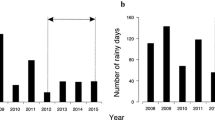Abstract
Arafura filesnakes (Acrochordus arafurae) are large (up to 2.5 m, 5 kg) aquatic nonvenomous snakes that feed entirely on fishes. A 10-year field study in the Australian wet-dry tropics revealed strong correlations between rainfall patterns, fish abundance, and snake population dynamics. All of these characteristics showed considerable annual variation. High rainfall late in the wet season (February–March) caused prolonged inundation of the floodplain. Following such years, dry-season sampling revealed that fishes were abundant, filesnakes were in good body condition, and a high proportion of adult female filesnakes were reproductive. Annual variation in recruitment to the population (as judged by the relative abundance of yearling snakes) was also correlated with fish abundance and thus, with rainfall patterns in the late-wet season. Our results fit well with those from other studies on a diverse array of aquatic and terrestrial species within the wet-dry tropics. Annual variation in rainfall patterns, via its effects on prey abundance, may drive the population dynamics of many tropical predators.
Similar content being viewed by others
Author information
Authors and Affiliations
Additional information
Received: 28 June 1999 / Accepted: 29 February 2000
Rights and permissions
About this article
Cite this article
Madsen, T., Shine, R. Rain, fish and snakes: climatically driven population dynamics of Arafura filesnakes in tropical Australia. Oecologia 124, 208–215 (2000). https://doi.org/10.1007/s004420050008
Issue Date:
DOI: https://doi.org/10.1007/s004420050008




